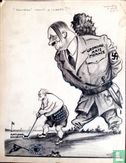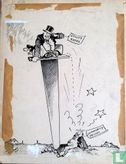

Enlarge image


Catalogue information
LastDodo number
5648339
Area
Drawings / paintings
Title
Yoo-hoo! Want a caddy?
Artist
Art object
Art Movement / style
Genre
Material
Technique used
Colouring
Dimensions
37 x 28 cm
Series / hero
Collection / set
Number
Addition to number
Year
1940
Country
Language
Details
Original editorial cartoon on card in pen, ink and crayon, 1940, syndicated to a number of newspapers, shows the armed figure of Hitler looming over the USA, the ‘growing Axis menace’, which had already taken over large parts of Western and Central Europe. He is offering his assistance as ‘caddy’ to ‘Congress’, which is playing a game of golf with a ball representing ‘national security’, the hole representing ‘political expediency’. They could probably use the help of someone like Hitler, who knew all about rearmament, in increasing the military state of preparedness of the USA. At the outbreak of war in Europe 1939 this was inadequate for any meaningful contribution - an overwhelming majority of the American people wanted in any case to stay out of the war if they could, and this sentiment governed the initial US response to the ominous international situation. By 1940 however Congress had abandoned neutrality and appropriations for military spending increased dramatically. ‘Short army training hitches’ probably refers to the fact that the large scale nature of the operation in 1940 ran into organizational problems and particularly lack of modern military equipment. Card size 37 x 28 cm (14 x 11 inch), image size 32 x 26 cm, signed lower right with nine zeros as underline. Caption in pencil in upper border, in very good condition.
Verso: “Who said no marathons?” Original editorial cartoon on card in pen, ink and crayon, 1940, syndicated to a number of newspapers, shows a figure representing ‘utility rates’ sitting on a pole with ‘commodity prices’ lying stunned on the ground below. Pole-sitting marathons had been very popular up until the early 1930s and, although attempts were made to ban them, they simply faded away when the Depression came. By the end of the 1930s the utility rates (gas, electricity, water) had been high for a long time, while commodity prices had been very low for a long time, making it very difficult for some sections of the population, e.g. farmers, to pay the high utility rates. Image size 30 x 26 cm, signed lower left with nine zeros as underline. Caption in pencil in upper border, paper remnants around borders, otherwise in good condition.



